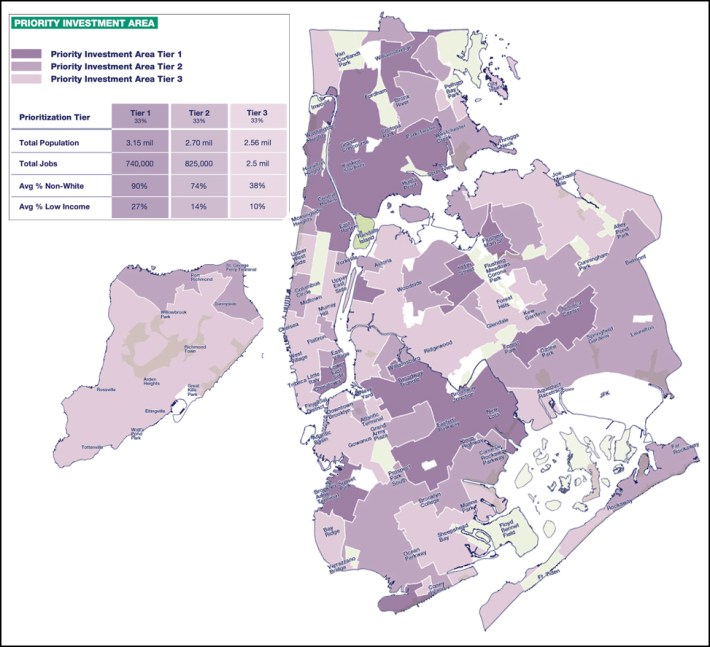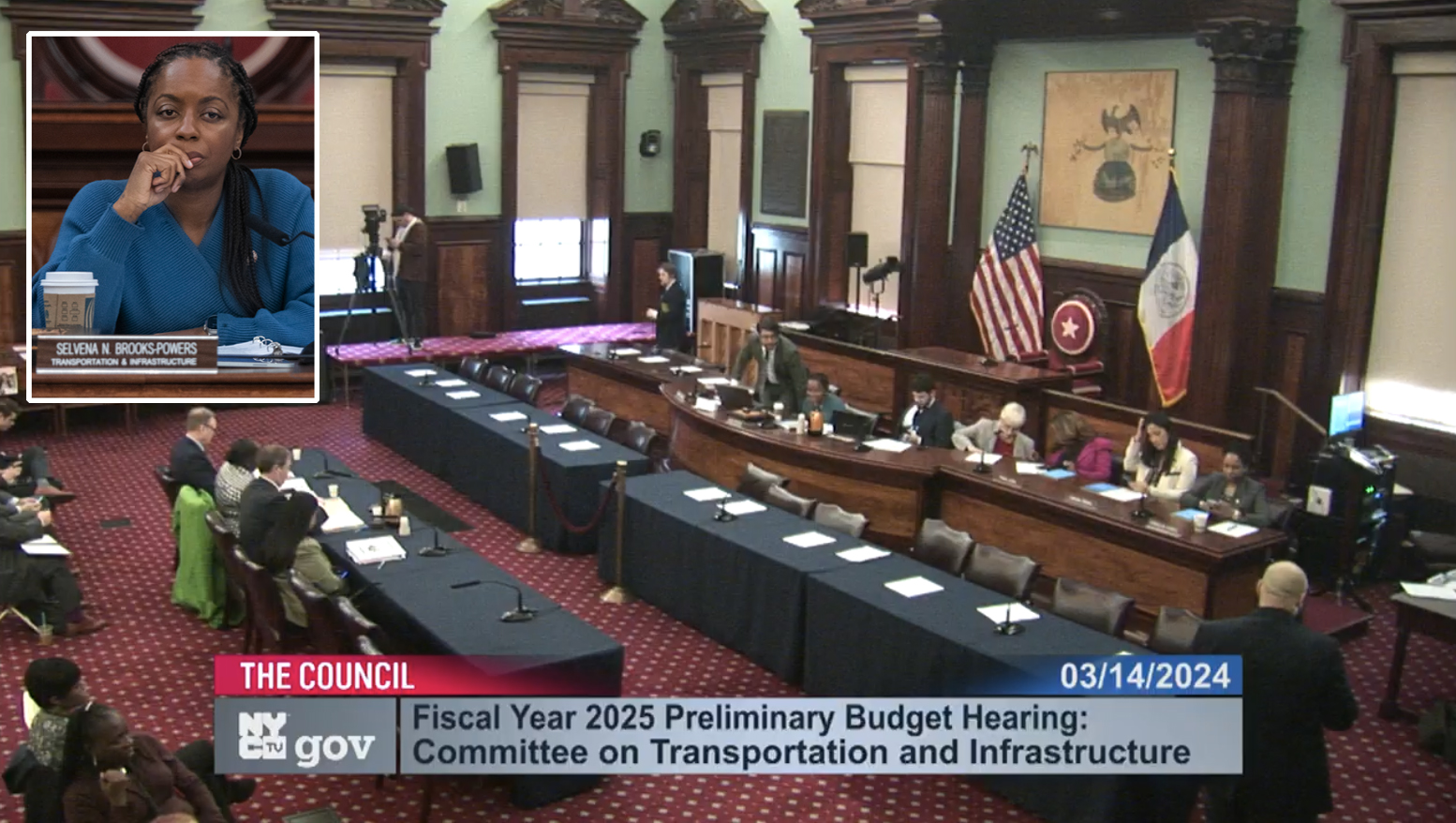What do bike lanes in Far Rockaway in Queens and East New York in Brooklyn as well as a redesigned Westchester Avenue in the Bronx have in common?
They’re life-saving projects that the Department of Transportation implemented only to be slammed at a hearing last week for making improvements that lawmakers in each neighborhood didn’t want.
The hearing partly focused on why the DOT has fallen short of its legal requirements under the Streets Plan to build 50 miles of protected bike lanes and 30 miles of bus lanes each year across the five boroughs. The DOT has said in the past that support from local lawmakers is essential to getting stuff done — yet here were three Council members opposing some of the very projects that help boost DOT’s numbers and increase safety.
“When the agency wants to place a bike lane somewhere, regardless of what the council member says or the community, DOT has done it,” Transportation Committee Chair Selvena Brooks-Powers (D-Queens) said, in this case referring to the Seagirt Boulevard project in 2022.
Brooks-Powers's contention that the DOT is doing unwanted projects in her district is directly contradictory to her position last month, when she criticized the agency for its failure to not only meet its requirements under the Streets Plan, but to do so in districts like hers.
"Outer borough communities of color like mine desperately need urgent investments in our street infrastructure," she said.
Statement on Streets Plan 2024 Update from @NYCCouncil Majority Whip Selvena N. Brooks-Powers: pic.twitter.com/L79UQaFJmV
— CMSelvenaBrooksPowers (@CMBrooksPowers) February 23, 2024
It’s unclear why Brooks-Powers is still miffed about the Seagirt Boulevard project given its success: according to city crash data, the stretch of Seagirt Boulevard between Rockaway Freeway and Beach Ninth Street had 86 crashes in 2019 and 87 crashes in 2013 — but the number of crashes dropped to 48 in 2023, a decrease of more than 44 percent.
And 232 people were injured on the strip between 2015 and 2019, or an average of 46 people per year. Last year, 28 people were injured, a drop of 40 percent.
The wide strip also encouraged speeding, with 800 speed-camera tickets issued per day. But narrower roadways, painted pedestrian islands and daylighting treatments have decreased speeding, the agency has said.
And despite what Brooks-Powers believes, DOT said that 84 percent of residents surveyed showed support for the recommended safety improvements.
In addition to Brooks-Powers, Council Member Christopher Banks (D-Brooklyn) had some issues with DOT, calling for the removal of the new bike lanes on Cozine and Wortman avenues — the longest protected bike lane project in East New York. He argued the project created a public safety issue on streets that were each averaging about 80 reported crashes per year before the work was done, as Streetsblog reported.
Banks was not in the Council when this project was in the planning phase, but the DOT told community members that the agency was moved to act after two children were killed in 2020. Speeding on dangerously designed roads were cited by 46 percent of parents as the main reason they don’t let their kids walk to school.
The new infrastructure, complete with shortening crossing times for pedestrians and lower vehicle speeds, have lowered deaths and serious injuries in the area by more than 18 percent, DOT officials have said. In the five full months before the project was completed, there were 53 reported crashes in the area, injuring 38 people.
In the five full months after, the number of crashes dropped to 42 and injuries dropped to 23, city stats show, decreases of 21 percent and 39 percent almost overnight.
DOT Deputy Commissioner Eric Beaton retorted that the project was a two-year-long effort in collaboration with a nearby school and residents with the shared goal of deterring speedsters from the area.
“It was a dangerous street,” Beaton said. “Rather than just go with enforcement, rather than just go with speed cameras, we wanted to make sure that the neighborhood got the same level of investment, the same types of redesigns that we do elsewhere in the city.”
That didn’t satisfy Banks, who said nearby NYCHA tenants don’t want the bike lane project because it gobbled up spaces for the storage of cars and created less visibility for motorists.
“There are new tenants that are coming in,” Banks said. “So we don’t have parking, there are bike lanes that are putting pedestrians, the folks who are driving, coming out of parking lots, in danger, and it’s just been a mess.”
He also said the area is now less safe, but cited no evidence.
His position is contrary to what he told StreetsPAC, the political action committee, when he first ran for the Council in 2013. In seeking an endorsement then, Banks told the advocacy group that he "is eager to bring much-needed bicycle and pedestrian infrastructure to the neglected roadways ... envisions a bicycle lane along New Lots avenue, and proposes a complete-street makeover for 10-lane Linden Boulevard."
And Council Member Rafael Salamanca Jr. (D-Bronx) told the DOT that its 2022 street project for Whitlock Avenue and Southern Boulevard has caused congestion and safety concerns.
It’s unclear how the area could be worse: Between 2014 and 2018, there were 157 injuries from crashes on Westchester Avenue between Southern Boulevard and Whitlock Avenue, according to city data, or an average of 31 per year. Last year, there were 26, a 16-percent drop, partly due to the new crosswalks, expanded sidewalk space and median islands.
The council member wasn’t satisfied.
“I want to warn my colleagues [to] just be mindful of these redesigns that DOT implements: you have individuals that do not live in our communities that are making decisions for our communities and are creating major congestion in our communities,” said Salamanca, who met with DOT officials at least three times in 2021, including two walk-throughs, according to agency documents.
Next, Salamanca moved away from his complaint about the project he didn't like to complain that DOT does not do enough safety work in neighborhoods that have traditionally been under-served.
“These plans are leaving communities, especially communities of color, out to dry,” he said.
Under Mayor Adams, the DOT has said that it is prioritizing safety redesigns in neighborhoods with the highest poverty levels and most residents of color, such as Salamanca's District 17, where 30 percent of the residents are below the poverty line and 95 percent of the residents are Black or Latino, according to the census, and traffic fatalities and injuries are the third-highest in the city.
Such under-served neighborhoods receive proportionally more miles of street redesigns than wealthier and whiter populations, the DOT said in a statement. Neighborhoods with the highest poverty levels contain 11 percent of street redesign miles and 8 percent of total street mileage. And neighborhoods with the most residents of color got 22 percent of the street improvement projects, despite having 21 percent of the roadway mileage.

And the pace appears to be accelerating: Since the pandemic, DOT said it completed more than 150 street redesign projects what it is calling Tier 1 and Tier 2 priority investment areas (darkest shading on the map). As a result, the agency said, there has been a 30-percent drop in fatalities involving Black victims over the last two years.
DOT Commissioner Ydanis Rodriguez bristled at the notion that his agency ignores the elected leadership of a neighborhood, pointing out that all DOT projects are informed by local data and conversations with members of the community and their elected representatives.
“Mayor Adams has instructed all agencies to … work closely with all council members,” said Rodriguez. “So whatever is important for you, is priority for us.”
So that raises the question: What's important to some Council members?






